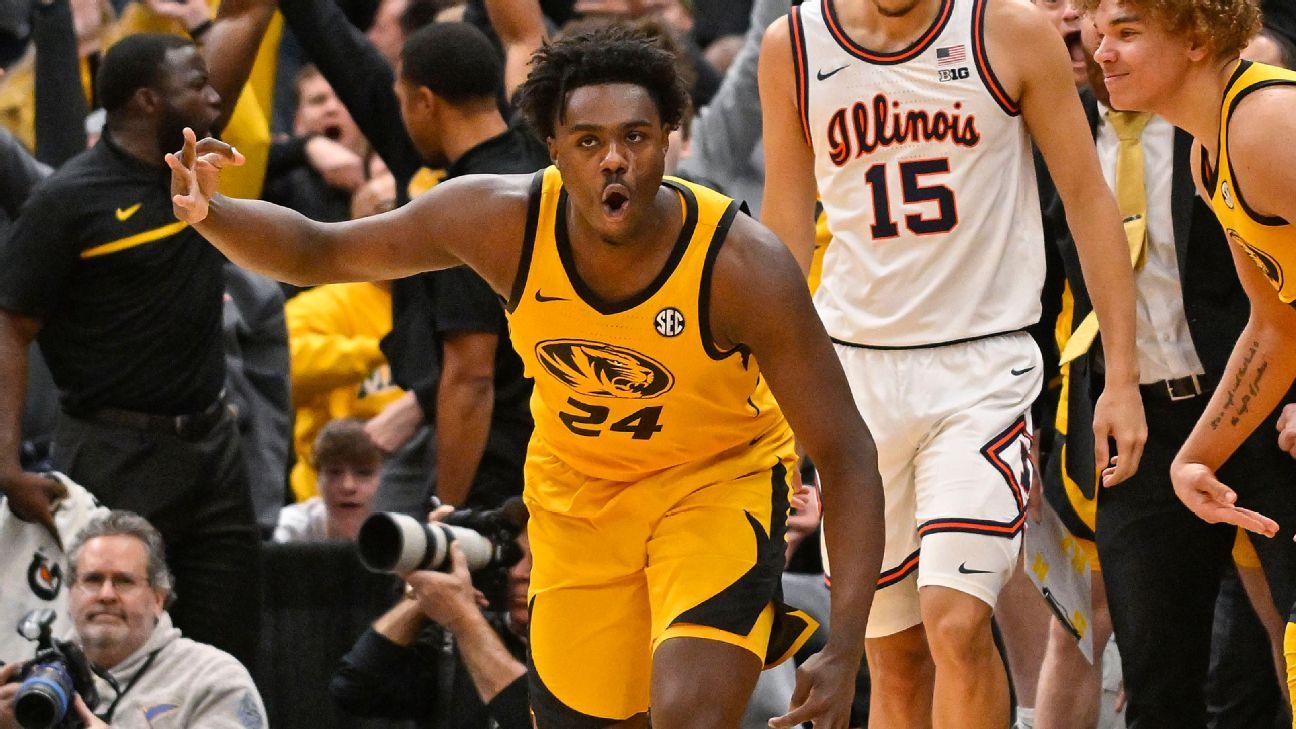It has been a season of surprises so far in men’s college basketball. The top four teams in the preseason AP poll had 13 combined losses entering Wednesday, while the current top five features two teams that weren’t even ranked in the preseason top 25.
As marquee neutral-site games and early-season tournaments fade from memory and conference play takes center stage, though, some of the November and December upstarts will begin to fade. It happens every season. Minnesota started last season 10-1 — before winning just three of its final 19 games. DePaul was initially 9-1, and finished 15-16 overall.
But some have staying power. Arizona was picked in the middle of the pack of the Pac-12 last season but earned a 1-seed in the NCAA tournament after winning the league. Iowa State went from last in the preseason Big 12 poll to the Sweet 16.
We decided to look at a few of the more uncertain surprising teams around the country, some of the most difficult teams to gauge at this point in 2022-23. Specifically, three from the top six leagues that were picked in the bottom half of the conference in the preseason and yet had fewer than expected losses: Missouri (two), Kansas State (one) and LSU (two). Throw in New Mexico, the last team to lose a game this season, and you have four of the biggest surprises in the country.
High-end surprises like Purdue and UConn? We know they’re very good. But to get a better feel for the aforementioned quartet, we reached out to coaches who have faced them this season. Are they for real? Or are they simply in a good run of form?

Kansas State Wildcats
Record: 13-1
Key results: Wins against Texas, West Virginia and LSU; loss at Butler
Preseason ranking: 10th in the Big 12
Why they’re for real: Well, they just scored 116 points at No. 6 Texas on Tuesday, the most points an unranked team has ever scored in a road win over a top-10 team, according to ESPN Stats & Information research. We could probably just end the argument there — but we won’t.
First-year head coach Jerome Tang has one of the most experienced teams in the country, headlined by nine former Division I transfers and a couple of junior college imports.
“I’m not sure why people are so surprised,” one opposing coach said. “They have a talented roster and a really good staff that has them playing with confidence.”
“It’s easy to see they have an identity,” another coach said. “They want to play hard, play fast, play through [Markquis] Nowell off the bounce and in pick-and-roll, and isolate [Keyontae] Johnson on the block and in the post. They want to outwork you in every facet of the game.”
Tang has two legitimate stars to lead the way in former Florida transfer Johnson and Nowell. Before this season, Johnson hadn’t played since collapsing in a game against Florida State in December 2020. Fully cleared to play last summer, Johnson is having the best campaign of his career, averaging 17.7 points and 6.8 rebounds and shooting 57% from the field and 42.5% from 3.
0:21
Markquis Nowell throws the lob from half court to Keyontae Johnson for the dunk.
“Johnson is a game-changer,” one coach said. “He’s a guy that can set the pace, scoring-wise. He can just be that steady force when you need a basket. Put the ball in his hands, he’ll make a 3, get to the line, post or drive it. He’s just a reliable double-digit scorer. As you get into conference play and teams know your stuff, he’s a guy that, even if you know their stuff, he’ll find a way to put up points.”
Nowell, who started his career at Little Rock, has been one of the nation’s premier distributors this season. He’s also coming off one of this season’s best individual performances on Tuesday: 36 points on 14 shots, nine assists, one turnover, three steals and a perfect 12-for-12 from the free throw line.
“He’s mastered the ability to score and make plays, put the ball in the hole and make the game easier for his teammates,” an opposing coach said. “He’s a lead guard who knows how to play, score and distribute, and manage a game. That’s crucial to being able to win.”
“We were worried about him making plays out of the ball screen, throwing it back to guys on the backside. Our ball-screen defense against him,” a coach added. “He’s a high-assist guy. Outside of Johnson, we didn’t really feel like they had a guy who can go out and get 20. Nowell makes their role players really good because of his ability to see the floor.”
Why they’re not: The one area Kansas State could be potentially vulnerable is on the interior, at both ends of the floor. The Wildcats aren’t a great defensive rebounding team, ranking in the bottom half nationally in the category, and they’ve struggled against high-level post players a few times this season.
West Virginia’s Tre Mitchell went for 16 points and 13 boards against them last weekend. Manny Bates had 22 points and 10 boards in the Butler win, and LSU’s KJ Williams finished with 17 points and 10 rebounds.
0:17
Markquis Nowell knocks down long 3-pointer vs. Texas Longhorns
“You have to play inside-out, try to get a bunch of paint touches,” one coach said. “They gang rebound pretty well, [Nae’Qwan] Tomlin sticks his nose in there, and Johnson is a phenomenal rebounder from the 3-4 spot. But not having an anchor inside the box to block shots and defensive rebound and protect the rim is the one thing they’re missing.”
Offensively, Tomlin — a 6-foot-10 junior from New York — was struggling for consistency early in the season. He had back-to-back scoreless efforts against LSU and Butler at the end of November but has been on a tear recently. Tomlin was averaging 15.5 points and 7.0 boards entering Tuesday’s game, then had 11 points against the Longhorns. Between Tomlin and senior Abayomi Iyiola, getting reliable production inside is key.
“They need someone they can throw the ball into outside of Johnson,” one coach said.
When we might know: After Tuesday’s 116-point showing at Texas, we might already know. But the Big 12 is a gauntlet, so it shouldn’t take very long to see how the Wildcats build on that win. They head to Baylor on Saturday, then get three of four games at home: vs. Oklahoma State, at TCU, vs. Kansas, vs. Texas Tech. The Wildcats will look to prove they belong in the top half of the league during that stretch.
0:21
Kobe Brown nails the 3-point shot vs. Illinois Fighting Illini

Missouri Tigers
Record: 12-2
Key results: Blowout wins against Illinois and Kentucky; blowout loss to Kansas; loss at Arkansas
Preseason ranking: 11th in the SEC
Why they’re for real: There might not have been a team in the country with more momentum during Christmas week than Missouri. The Tigers blew out rival Illinois on Dec. 22, took a few days off for the holiday, then returned to the court and battered Kentucky by 14 in a game that wasn’t that close. It put the nation on notice: Dennis Gates came to Columbia to win in Year 1.
“It wasn’t so much what they did, it’s how they did it,” said one coach who faced them earlier in the season. “It’s all guys that are transfers that have something to prove. They play really hard, they play smart. They’re tough, they’re scrappy, they play with a chip on their shoulder. It’s guys that have played a lot of college basketball. They’re not afraid of the moment.”
Any conversation about Missouri right now has to start with Kobe Brown. A holdover from the Cuonzo Martin era, Brown’s games against Illinois and Kentucky were historically good. He averaged 30.5 points, 5.5 rebounds and 5.0 assists in both, shooting 60.6% from the field and 58.3% from 3.
“He’s shown flashes during his career — he was second-team all-league last year,” one coach said. “He has a unique game where he can handle the ball, he’s comfortable bringing the ball up — not as a point guard, but he can grab and go and initiate some type of offense. He has versatility, he can play 1 through 5, and Gates has done a good job of surrounding him with shooters and other pieces. He’s really been able to accentuate his game.”
Gates built his roster primarily through the portal, bringing in nine transfers last spring. But it was clearly with a purpose. Outside of 5-10 point guard Nick Honor, Missouri’s entire team is essentially 6-3 through 6-8. The versatile nature of the lineup causes matchup problems for opponents and also means nearly every player on the team can make shots from the perimeter. Entering Wednesday, five players had made double-digit 3s.
“They play so many interchangeable guys,” one coach said. “You have to guard the 3-point line, there’s nobody you can disrespect. You have to guard them the entire half court.”
The most noticeable stylistic aspect of the Tigers this season is their pace and defensive pressure. They play at one of the fastest tempos in the country, and rank No. 3 nationally in defensive turnover percentage and No. 1 in steal percentage.
“Defensively, it’s a little helter skelter. They mix up their traps and denials,” an opposing coach said. “It’s very random. It’s organized chaos. When you’re watching them, you’re trying to find themes or what they’re trying to do, and it’s hard. They do some unique things. They’ll trap out of a zone. They have freedom to trap. And with the press, because you have to spend eight seconds on the press, by the time you get your offense set, you only have time for one action. That’s what can be difficult.”
“It’s not necessarily that you start turning the ball over every possession, but over the course of 40 minutes, holy s–t. You have to work for every possession,” another coach said. “In some ways it’s more mental than physical.”
Why they’re not: Missouri found itself on the other side of a blowout result earlier in December, when Kansas came to town and ran the Tigers out of their own gym by the 15-minute mark of the first half. It was never close, with the Jayhawks cruising to a 38-point win.
2:28
Following the 105-69 win over Houston Christian, Dennis Gates credits the players for “buying in” to a new offensive plan and building strong chemistry.
Unsurprisingly, Missouri had its worst defensive performance from a turnovers perspective all season. Kansas coughed it up on just 18.3% of its possessions, compared to the 26.1% rate Missouri has on the season. That game also came in the middle of a four-game stretch of narrow wins, in which Missouri allowed opponents to make double-digit 3s in every game.
“They’re more susceptible to 3s than dribble drives,” one coach said. “Kansas picked their press apart because they would throw the ball up the court, drain a one-pass 3. Then the next play they would drive it, or [Gradey] Dick would get open for a 3. You have to be able to beat their press with the 3 and the drive. They want you to throw a pass over the top and jack up a 3 every time.”
While similar heights up and down the roster make for an interchangeable, positionless look, it has also left Missouri vulnerable on the defensive glass and without consistent shot-blockers at the rim. It ranks in the bottom 10 nationally in defensive rebounding percentage, and no single player is averaging more than 0.6 blocks. And while the Tigers don’t turn it over at a high rate, one coach noted they tend to commit more live-ball turnovers that lead to easy baskets at the other end.
More than anything, it’s about handling their defensive chaos and responding to the inevitable momentum the Tigers gain when they go on a run off a couple turnovers.
“They ran Illinois and Kentucky out of the building because that chaos got to them,” one coach said. “Kansas was unfazed.”
When we might know: Not a lot of teams will win in Fayetteville this season, so losing at Arkansas on Wednesday night isn’t a sign the Tigers will fade quickly. The schedule eases up (or as much as it can in the SEC) with games against Vanderbilt, Texas A&M and Florida up next. Back-to-back games on Jan. 18 and Jan. 21 should be telling: vs. Arkansas and vs. Alabama.
0:18
KJ Williams knocks down the triple

LSU Tigers
Record: 12-2
Key results: Close wins against Arkansas and Wake Forest; close losses to Kansas State and Kentucky
Preseason ranking: Eighth in the SEC
Why they’re for real: Matt McMahon’s team was a question mark entering the season, and it had a lot more to do with the way the roster was constructed than the actual talent level. At one point in the spring, LSU had its entire roster in the portal. So McMahon had to piece together transfers, high schoolers, roster holdovers and also bring some guys from Murray State with him. But it’s an older team, loaded with players with experience at high-major programs or in McMahon’s system.
And that has been evident through the first couple months of the season.
“Matt’s got them playing hard and playing together,” one opposing coach said. “There’s an underdog mentality among the group. Will [Wade] was getting all these top-ranked guys, and a number of the guys on this team are coming from Murray State and other programs — just the way that roster was thrown together. Matt has them believing they can compete night in and night out.”
LSU has caused issues for teams with the way it imposes its style on them. Against Arkansas in the SEC opener, the game featured 68 possessions — almost four fewer than the Razorbacks average this season. The Tigers really slow things down on the defensive end, ranking in the bottom 50 nationally in average possession length, according to KenPom.
On the offensive end, the Tigers are methodical and prefer to get KJ Williams and Adam Miller the majority of the team’s shots. Williams’ production as the OVC Player of the Year last season has carried over to the SEC, where he’s averaging 18.5 points and 8.0 rebounds while shooting 49.0% from 3. Miller, a former heralded recruit who left Illinois after his freshman season and missed all of last year after tearing his ACL, is averaging 13.0 points and had three games of 23 or more points in November.
0:17
From downtown, Adam Miller hits the deep 3-pointer
“Something they do really well is their pace of play,” one coach said. “They slow the game down, they run a lot of sets. Everything they run is for KJ Williams or Adam Miller. There are really no surprises. They do what they do. But you have to anticipate how much of the shot clock they’re going to run. And then they take teams out of their transition game. They do a good job of picking their spots on when they’re going to play zone. You know it’s coming, but you don’t know when.”
“Offensively they don’t do anything overly complex,” another coach added. “They run a lot of sets, they execute their sets, and you know it’s coming but you still have to stop them. They know what they’re doing.”
One area LSU has excelled so far this season is perimeter defense. Teams simply aren’t hitting 3s against the Tigers. Wake Forest went 5-for-24 from 3, Arkansas went 4-for-25. Eight teams have made five or fewer 3s against LSU. Some of that is variance, but they still rank in the top 25 nationally in 3-point percentage defense, with opponents shooting just 28.2% from 3.
“They bait you into shooting 3s,” one coach said. “They back off a little bit. They let your non-shooters shoot.”
Why they’re not: The lack of a reliable third scorer had been an issue at points this season, especially with Miller struggling in recent weeks as opponents keyed on him. Some teams have face-guarded him, others have used their best perimeter defender. Before scoring 15 points against Kentucky, he was averaging 6.8 points and shooting 20.4% from the field in his previous five games.
“They go into dry spells scoring the ball,” one coach said. “They can go three, four, five minutes without scoring a basket. If KJ Williams gets into foul trouble, there’s a huge drop-off to Kendal Coleman and Jalen Reed.”
Fortunately for McMahon, former South Carolina and Murray State transfer Trae Hannibal has stepped up, scoring 19 points and taking over against Arkansas and then scoring 12 against Kentucky — after hitting double figures in one of his first 12 games.
Defensively, coaches said LSU is vulnerable with its ball-screen defense and can also struggle on the defensive glass.
“They can look unorganized in their pick-and-roll defense at times,” one coach said. “Wake Forest shot like 75% from 2 against them but missed a lot of open shots from 3. They don’t do much to disrupt you.”
“They’re not a good defensive rebounding team. You can get them on the offensive glass,” another coach added. “East Tennessee State annihilated them on the offensive glass.”
When we might know: The Tigers’ first true road game of 2022-23 was Tuesday’s loss at Kentucky, so they first need to prove they can win on the road in the SEC. They head to Texas A&M on Saturday before hosting Florida — and then they begin a brutal stretch on Jan. 14: at Alabama, vs. Auburn, vs. Tennessee, at Arkansas. If they can win one or two of those four, that should be considered a huge positive.
0:21
Jaelen House fights off defender for and-1

New Mexico Lobos
Record: 14-1
Key results: Wins against Saint Mary’s and Iona; loss at Fresno State
Preseason ranking: Fifth in the Mountain West
Why they’re for real: Richard Pitino has the best backcourt in the Mountain West and one of the most dynamic guard duos in the country outside of the power conferences in Jamal Mashburn Jr. and Jaelen House. Both are averaging better than 17 points per game, with House also chipping in with 5.3 assists, 2.9 steals and 47.5% shooting from 3.
“They have two guards that can hoop. House and Mashburn can hoop,” one coach said. “They beat you with catch-and-shoot 3s, they beat you off the bounce, pick-and-roll, isolation situations. They can go make plays, you don’t have to run plays for them. House and Mashburn aren’t shot-crazy. House is good at making crazy plays. He’s not vertically very athletic, but he has a willpower where he’ll block a shot or have a finish that makes you go, ‘Holy s—.’ Two or three of those plays every game.”
The third former transfer rounding out the Lobos’ core is Morris Udeze, who arrived in Albuquerque last spring after spending four years at Wichita State. Udeze is averaging career highs in points (15.7 PPG) and rebounds (7.5 RPG), and is providing the interior balance New Mexico was missing last season. Between those three, there simply aren’t many teams in the Mountain West that can match the Lobos for talent.
0:16
Morris Udeze somehow gets the and-1 to fall
“They don’t all work out, but a decent high-major transfer into the Mountain West can kick ass,” one coach said. “And they’ve got three of them.”
One coach in the league who watched the Lobos this season also pointed to superior offensive depth and guys buying into their roles so far as reasons for improvement, after already winning more games than they did all of last season.
“Josiah Allick and Javonte Johnson are their glue guys,” he said. “They might get 15 shots one game, three shots the next game, they do what they do. They defend, rebound, they take their opportunities. But they don’t need a ton of opportunities. Donovan Dent is an extra guy in the backcourt. KJ Jenkins has gotten better, too.”
We would be remiss not to mention perhaps New Mexico’s biggest edge in the regular season: The Pit, its home arena.
“When New Mexico’s good and they’re rolling, it’s one of the toughest places to play in the entire country,” one coach said.
Why they’re not: It will be interesting to see how the Lobos bounce back from their first loss of the season at Fresno State on Tuesday. Home games against UNLV and Oral Roberts are up next. And New Mexico needs to bounce back.
As one coach pointed out, the Lobos have a heavy reliance on jump-shooting. Not from 3-point range — they actually rank near the bottom of Division I in 3-point reliance — but midrange jumpers and long 2s. If their guards aren’t hitting those shots, it can be a long night for the Lobos.
“They rely on them and they have a confidence in their ability to make them,” he said. “Mashburn is not a great finisher at the rim, House is not a great finisher at the rim. They’re not paint touch guys. That’s why their frontcourt has helped them this season. It’s given them that paint touch element. So it’s gotten better, but it’s still a negative.”
A lack of size and depth could be an issue down the road, too. House, Mashburn and Jenkins are all 6-2 or smaller on the perimeter and the 6-6 Javonte Johnson plays a lot of power forward. New Mexico also ranks in the bottom 50 nationally in bench minutes and had only two bench points in the loss to Fresno State.
“Things are working out well for them,” one Mountain West coach said. “They’re staying healthy, they were doing enough to win close games [before Fresno] — but I think they’ll be in the 12-, 13-, 14-win range in the league. I don’t think they’re the best team in our league. They can beat themselves with shot selection. San Diego State doesn’t beat themselves.”
When we might know: Contenders in the Mountain West are compared to one team: San Diego State. So the Lobos’ trip to face the Aztecs on Jan. 14 should be circled on calendars. San Diego State had a couple hiccups in late November and early December but has now won four in a row and is the team New Mexico needs to keep pace with in the league standings.
